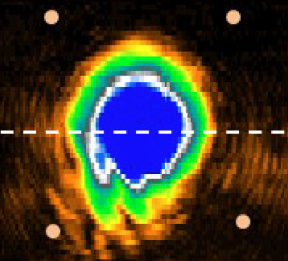Seeing quantum mechanics with the naked eye
January 10, 2012

Polariton condensate wavepacket visualizes quantum state
A University of Cambridge team has built a semiconductor chip that converts electrons into a quantum state that emits light and can be seen with a simple optical microscope.
Their quantum superfluid is simply set up by shining laser beams on the device; it can lead to practical ultrasensitive detectors. Quantum mechanics normally shows its influence only for tiny particles at ultralow temperatures, but the team mixed electrons with light to synthesize large (several microns) quantum quasiparticles that behave like superconductors.
They built microscopic cavities that tightly trap light in the vicinity of electrons within the chip, producing new particles called “polaritons” that weigh very little, encouraging them to move freely.
Dr. Gab Christmann working with Professor Jeremy Baumberg and Dr. Natalia Berloff of the University of Cambridge, together with a team in Crete, produced the special new samples needed which allow the polaritons to flow around at will without getting stuck.
Injecting them in two laser spots, they found that the resulting quantum fluid spontaneously started oscillating backwards and forwards, in the process forming characteristic quantum pendulum states known to scientists, but at THz frequencies.
The resulting quantum liquid has some peculiar properties, including trying to repel itself. It can also only swirl around in fixed amounts, producing vortices laid out in regular lines. Increasing the number of laser beams creates even more complicated quantum states.
The goal of the work is to make such quantum states using an electrical battery and at room temperature, which would allow a new generation of ultrasensitive gyroscopes to measure gravity and magnetic fields, and create quantum circuits.
Ref.: G. Tosi et al., Sculpting oscillators with light within a nonlinear quantum fluid, Nature Physics, 2012, in press.
Ref.: G. Tosi et al., Sculpting oscillators with light within a nonlinear quantum fluid, arxiv.org/abs/1111.7133